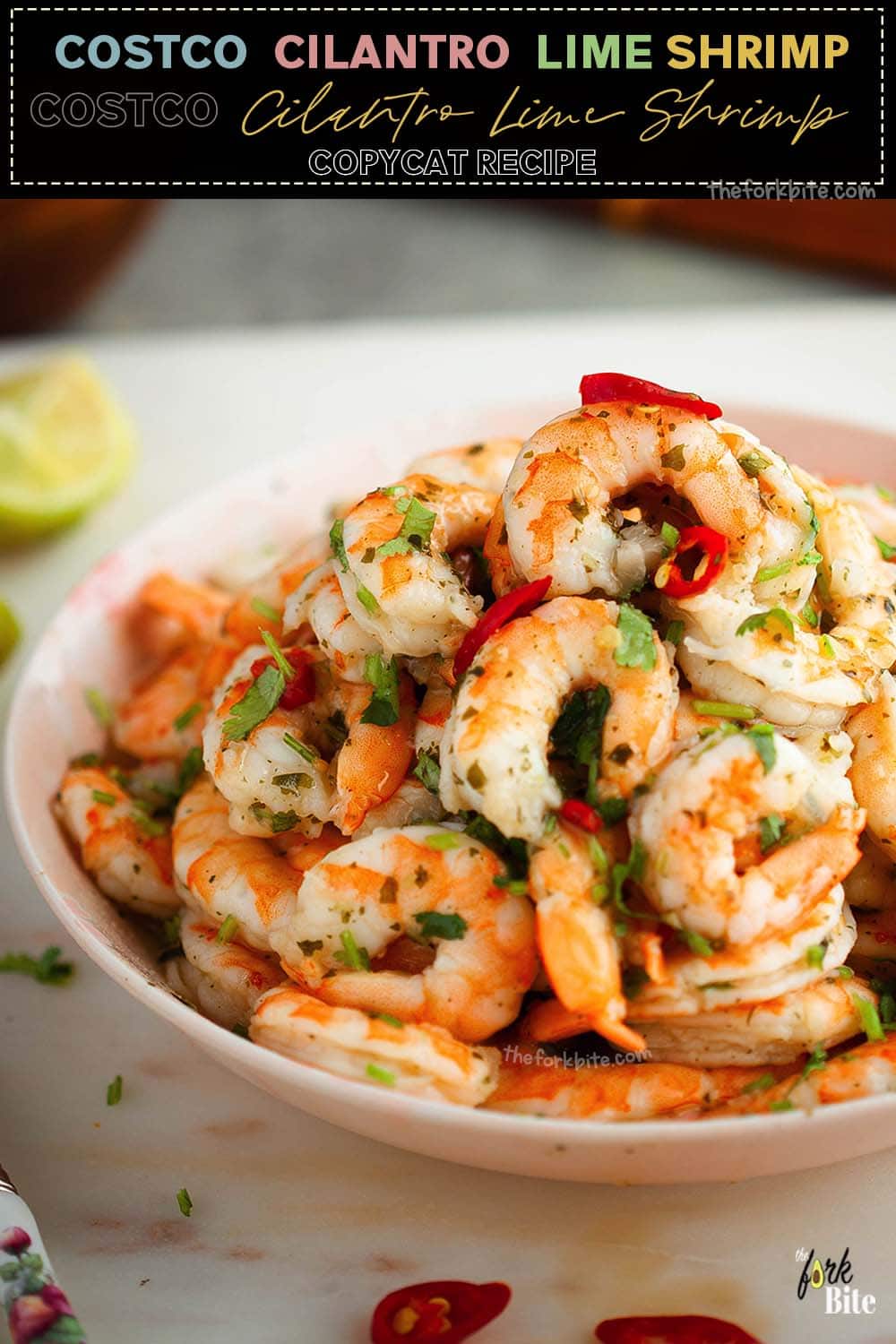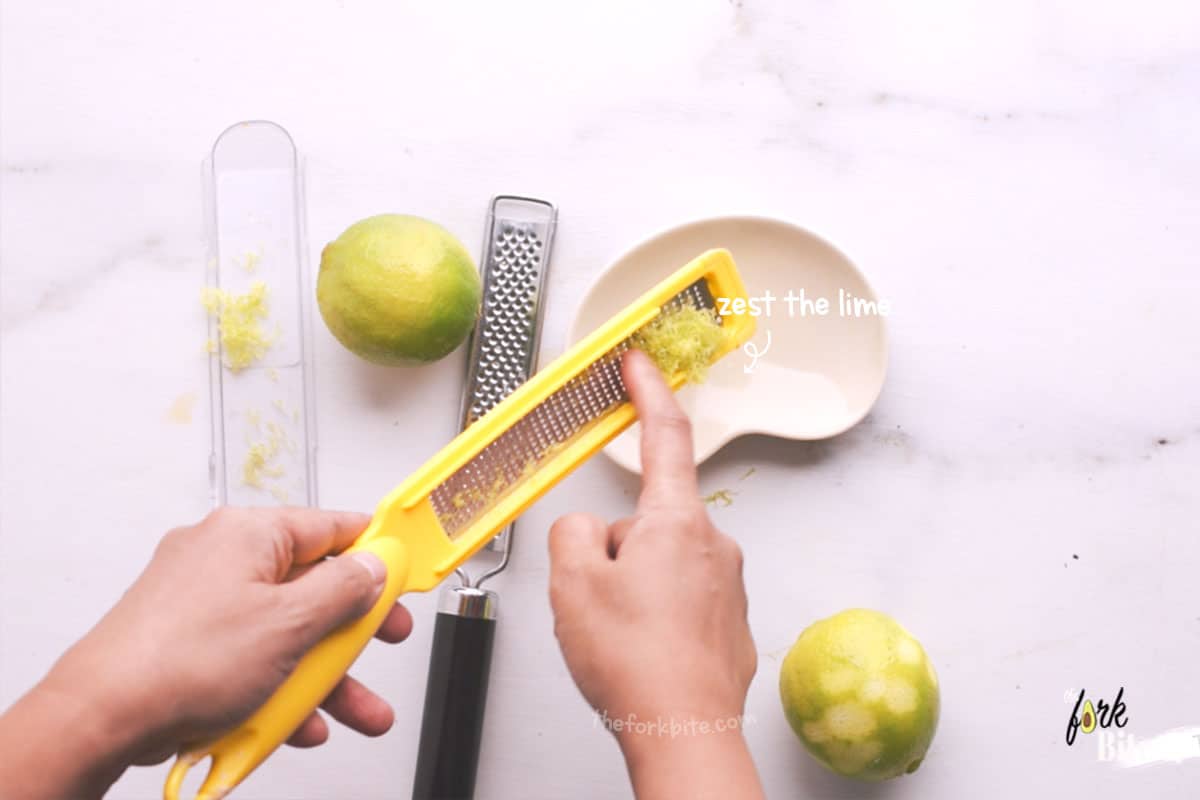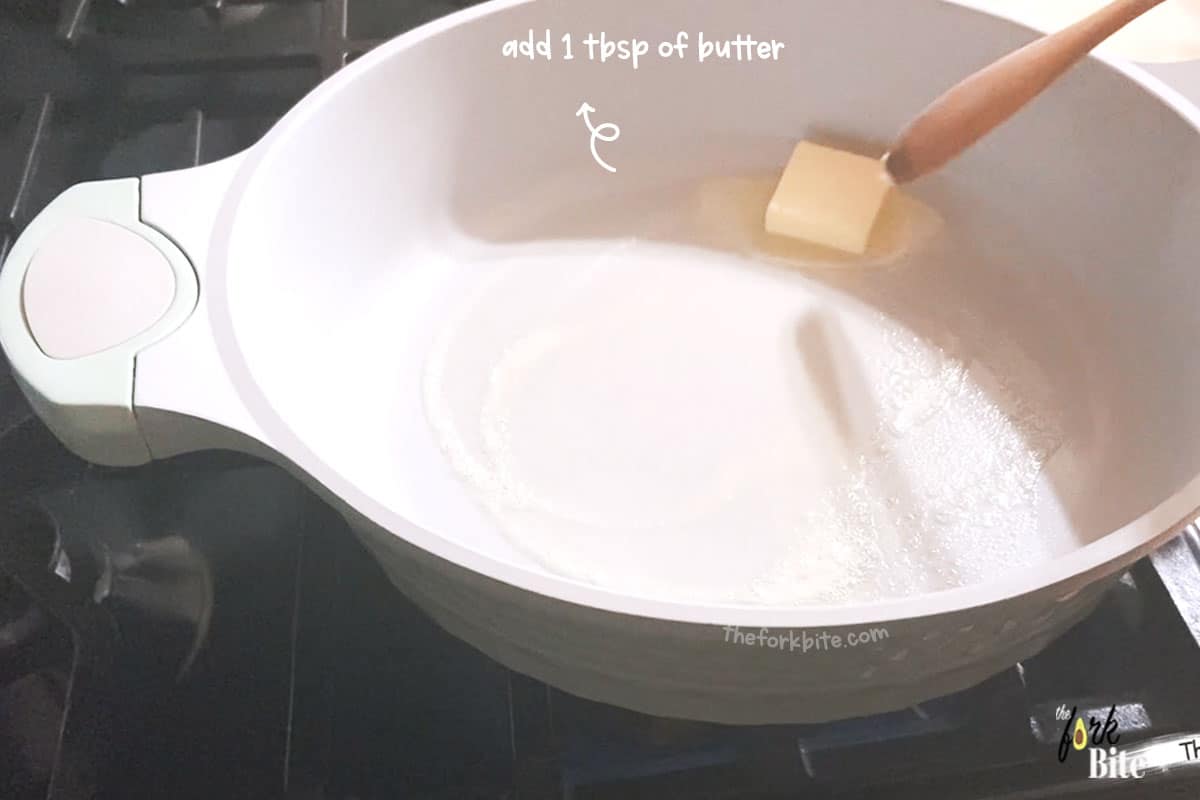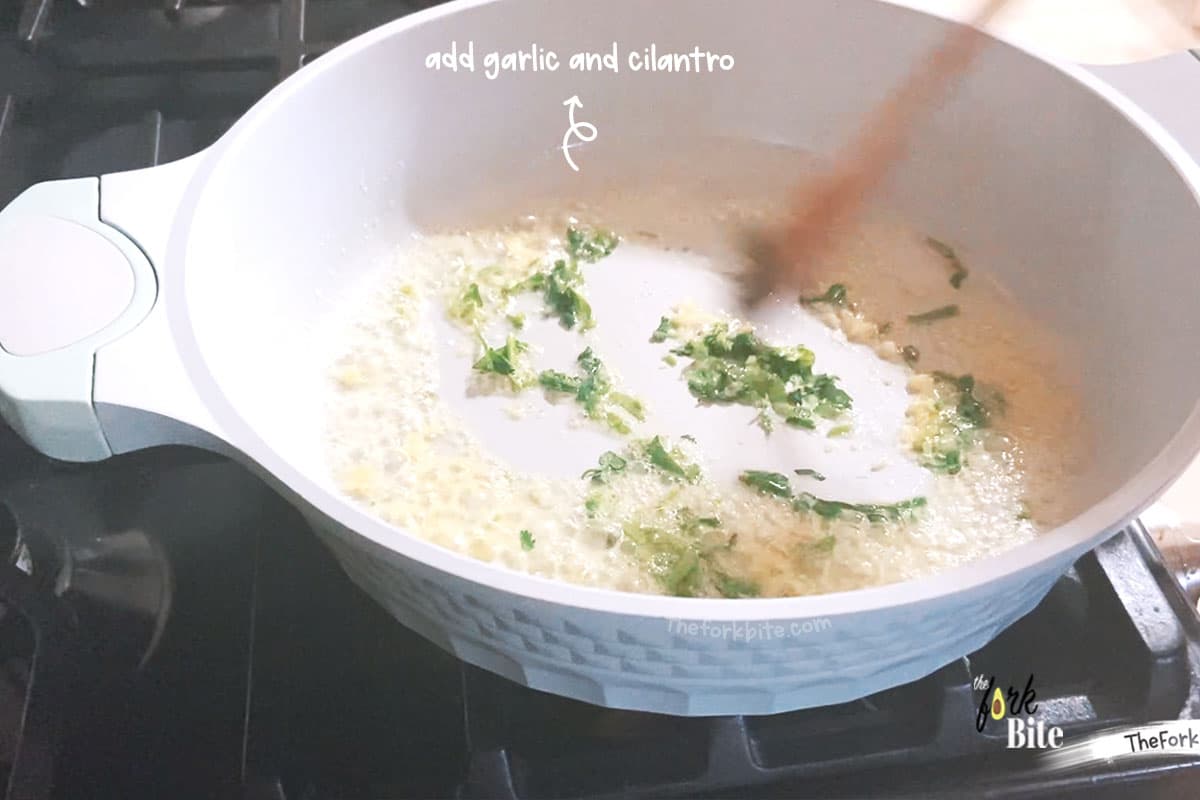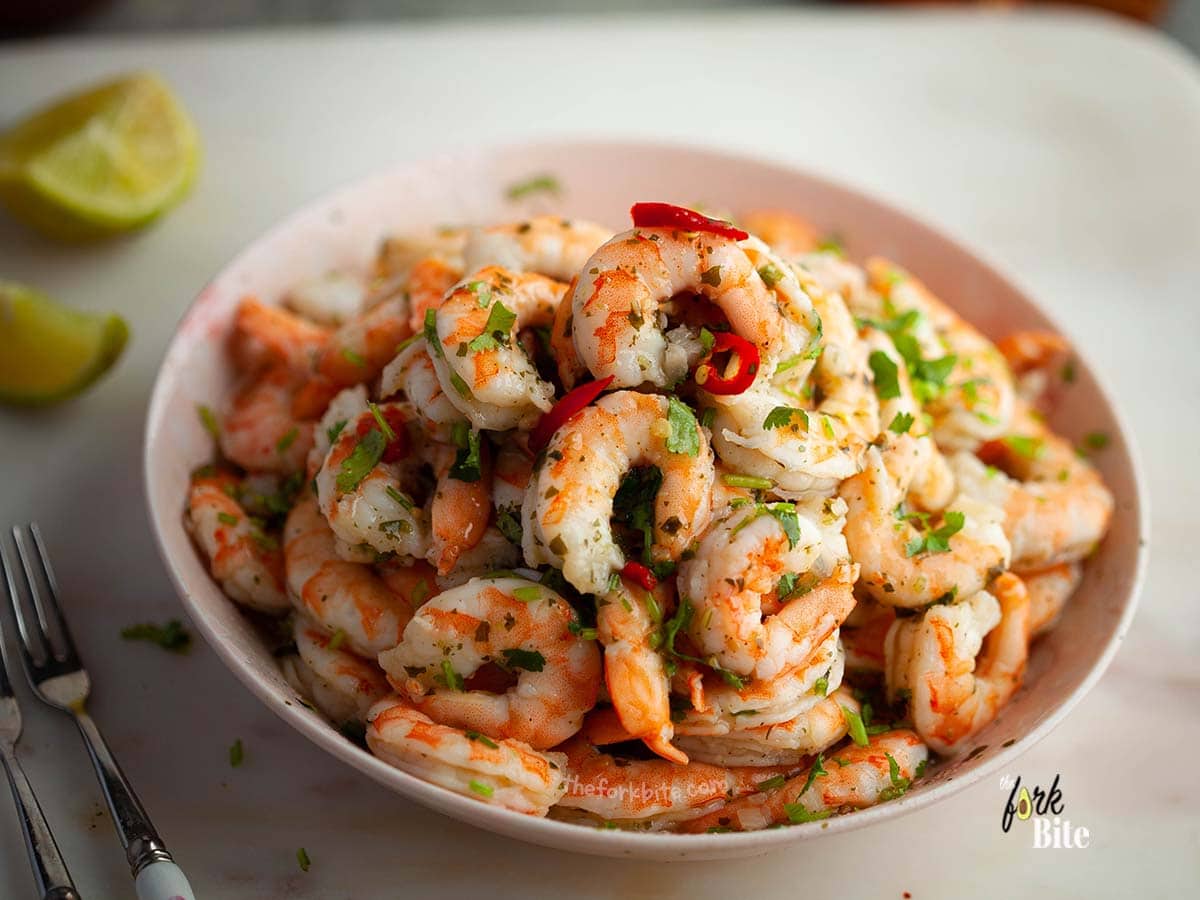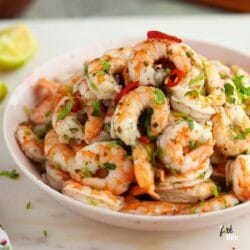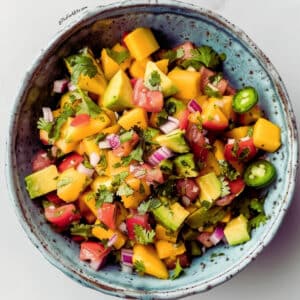Cilantro Lime Shrimp is a delicious dish, made unsurprisingly using cilantro, lime, and shrimps. The cilantro and lime are combined with butter to produce a gorgeous, silky dressing, and together with the shrimps, it makes an excellent snack or starter when paired with pasta, rice, tacos, or tortillas.
You don't have to stick rigidly to the recipe. You can substitute lime for the lemon and use other herbs such as basil, dill, or tarragon instead of the dried cilantro.
Shrimps are great ingredients for any dinner. They are healthy and nutritious, a cinch to cook, and absolutely delicious. This Costco cilantro lime shrimp is a simple recipe that only requires about 10 minutes of your time to make.
It is gorgeously fresh with a citrus tang and works superbly with Mexican flavors, served with avocado salad, rice, or tacos.
Jump to:
One of my favorite shrimp recipes
Shrimp is one of my all-time favorite ingredients. All it takes is a squeeze of lemon and some chopped parsley, and you've got the makings of a superb dish.
Make a couple of changes like throwing in some cilantro, lime, and butter, and you're on the way to food heaven.
You can make shrimp with this type of rich, zingy butter at the drop of a hat as long as you have the ingredients.
Watch the video
What's in this recipe?
This recipe has a tiny citrus kick that is delightful on the pallet and takes no more than 20 minutes to throw together. The ingredients couldn't be simpler.
The ingredients include:
- Large shrimps - these can be fresh or frozen, peeled or not. They can be tail on or tail off, whichever you prefer. Be as inventive as you like.
- The juice and zest of lime - use both to get the full limey tang.
- Cilantro - fresh, washed and chopped.
- Butter or olive oil - the choice is yours. Both are great for flavor, but the butter option offers a slightly more savory addition, while the olive oil is dairy-free if that's important to you.
- Fresh garlic - peeled and finely chopped.
- Cayenne or cumin or both - optional seasoning and spice.
All it takes to make this recipe is to heat the butter or oil, throwing the shrimp and toss, add the lime zest, and lightly saute for one or two minutes on each side until the shrimps become opaque. That's all there is to it.

What you are going to need
As I've already mentioned a couple of times (forgive me, I get excited when I am talking about my favorite dishes), the basic recipe is butter, cilantro, garlic, lime, and shrimp.
To take that exquisite flavor to the next level, I add another couple of tasty ingredients - coriander (ground) and scallions.
Coriander is another name for cilantro for those who don't know, and the ground version adds a taste boost.
How to make cilantro lime shrimp
With such a delicious ingredient as shrimp, you have no option other than to give it all you've got, and for me, a match made in shrimp heaven is garlic.
This is no recipe for sissies, so you're going to have to be prepared to use at least six cloves of garlic for every one pound of shrimp - even more, if you feel up to it.
To get the best flavor, we need to use all of the lime - both the juice and the zest. Remember, you can't afford to hold any flavor back, and using the zest and the juice will give you that extra flavor boost.
You won't believe the lime taste's pungency in the zest, and to ensure you get the best of it, remove it carefully with a Microplane. It's a great little tool, and if you haven't already got one, I thoroughly recommend you do so.
Cilantro is one of the best herbs going. However, I am aware that it's a bit of a turn-off for some people, so you can substitute any other tender fresh herb if this applies to you.
For maximum flavor, add the zest, the juice, and a generous amount of cilantro helping cilantro to the shrimp. Mix it all gently with your fingers to ensure an even distribution of those delicious flavorings.
Using butter in two ways.
Option 1
- Put one tablespoon of butter together with all of the garlic into a skillet.
- When the butter is melted, add the shrimp and cook briefly, add the lime zest as well.
- Before serving, sprinkle in the chopped cilantro, setting a little aside to sprinkle over the plated dish for presentation.
Option 2
- Cook as above, but just as the shrimp finishes cooking, take the skillet off the stovetop and add 2 tablespoon more butter, fresh chopped cilantro, and lime juice.
Removing the skillet away from the heat source means that it won't remain too hot, and as the butter melts, it will turn into a beautiful silky, unbelievably tasty sauce.
Serving suggestions
Cilantro lime shrimp makes the ideal family feast. You can serve them up straight out of the pan, unaccompanied, or with a side of pasta, a scoop of rice, or folded into tortillas.
Possible variations and substitutions
One of the great things about this particular recipe is that it is so versatile. With this variant, the source is made with butter, cilantro, garlic, and lime. If you'd like to experiment a little, why not try this?
Instead of cilantro and lime, use lemon and parsley.
This second option is pretty much as conventional lemon garlic shrimp would be.
But even that is open to experimentation, too, by swapping the parsley common for basil, dill, or tarragon. All three are tasty options.
Step by step instructions
Step 1
-
- Using a paper kitchen towel, dab the shrimp dry, add ¼ teaspoon of salt, and a few fresh ground black pepper twists.
Step 2
-
- Take your Microplane and peel off some lime zest, and set to one side. Using a paring knife, cut the lime into wedges, set aside.
Step 3
-
- Preheat your skillet on the stovetop and add a tablespoon of butter. Set two more tablespoons of butter aside for later use.
Step 4
-
- With the butter bubbling gently over medium heat, add the chopped garlic and a tablespoon of chopped cilantro. Cook for less than a minute, gently stirring all the time.
Step 5
-
- Add the shrimp, taking care not to stack them too much. Cook them for about one minute, stirring gently every few seconds to ensure that each shrimp cooks until all have turned pink. Note: I used the cooked shrimp for this recipe. You can try to cook in batches if needed to avoid over-crowding.
Step 6
-
- The (chopped) scallions are optional, but if you wish to use them, now is the time to put them into the skillet together with the lime zest. Add the seasoning.
Step 7
- Give them a quick stir to ensure that everything is coated in the sauce and cooked evenly.
- When done, slide the skillet gently off the stovetop.
Make the butter sauce
- Keeping the skillet off the heat all the time, add in the fresh chopped cilantro, the lime juice, and the two tablespoons of the butter you set aside earlier.
- Your skillet will retain the heat long enough to melt the butter as you stir the contents of the pan to amalgamate everything, creating a delicious, silky, buttery sauce.
- Season to taste and serve with some wedges of lime and a sprinkling of fresh cilantro.
Additional notes:
When using frozen shrimp, I revert to my quick defrost method.
- Place the shrimp into a Ziploc bag, seal it tightly, and put it into a bowl full of cold tap water. Let it thaw for about 20-30 minutes.
- Or you can put the Ziplock bag and place it into a bowl, turn on the cold water faucet, and run slowly into the bowl for approximately 15 minutes.
- From time to time, I have also made this dish using pre-cooked frozen shrimp. It works equally well but needs a little less time in the skillet as the shrimp is already cooked and only needs heating through for around two minutes.
Extra tips:
- Substitute lime and cilantro for the lemon and parsley, and cook as directed above.
- To give your dish another shot of flavor, add a little dry white wine and lemon juice towards the end of cooking.
- If, like me, you adore spiced up garlic shrimp, when you add the chopped garlic into the pan, throw in ½ to ¾ of a teaspoon of crushed chili flakes.
- If you want to forego the butter sauce's full creaminess, you can use olive oil instead of butter. Use one tablespoon for cooking the shrimp, and towards the end, drizzle in another half a tablespoon of oil.
Rubbery shrimp
If you end up with shrimp that is somewhat chewy, it's more than likely that it has been overcooked.
You can't rescue it, but next time you cook the dish, be sure not to have the heat too high and don't keep the pan on the heat for too long.
As soon as shrimp turns translucent pink, it is ready to serve. Cook it for longer, and it will toughen.
The general rule for cooking shrimp
- Straight shrimps are undercooked
- Curled or C-shape shrimps are perfectly cooked
- Shrimp that have twisted into an O-shape are overcooked. Overcooked shrimp are rubbery and sad.
How to perfectly cook shrimp
Cooking shrimp perfectly is important to get the best out of this delightful ingredient.
- As soon as the shrimp has turned translucent pink, take it off the heat without any noticeable grey spots.
You'll find it will be hot and moist with a delightful "crunch" to the flesh. Perfect!
Pro Tips:
When cooking shrimp, it requires an internal temperature of 120°F to achieve that perfect look. The longer you cook, the more it toughens the texture resulting in a tighter C-shape. Remember, shrimps cook quickly from grey color to light pink.
Frozen versus raw shrimp
I tend to buy my shrimp frozen because, quite honestly, it's so much more convenient. There's no huge difference between frozen and raw shrimp, although if it is frozen pre-cooked, it won't taste quite as fresh.
Many people wouldn't be able to tell the difference. But if you're a perfectionist and you prefer to use fresh raw shrimp, please go right ahead.
How to store
-
- When cooked, shrimp can remain at room temperature for up to 2 hours, after which it needs refrigerating.
- Place your cilantro lime shrimp into an airtight Tupperware container or Ziploc bag and store in the fridge for as long as four days, but no longer.
Can I freeze Costco cilantro lime shrimp?
If you buy shop-bought Costco cilantro lime shrimp, and you're not going to eat it straight away, you can freeze it.
- Lay the shrimp flat out on a baking tray and pop into the freezer for approximately one hour.
- Once frozen, it can be transferred into freezer-safe Ziploc bags, sealed, and frozen for up to around three months.
How to thaw frozen cooked shrimp quickly
It only takes between three to five minutes to cook shrimp from raw. If you are pressed for time, even that can put you under unwelcome pressure.
If you are well organized, you can defrost pre-cooked shrimp overnight (as recommended by the FDA), and the next day they will only take one to two minutes to cook.
But if you have been caught out and didn't get around to defrosting overnight, there are quicker thawing ways so you can defrost and cook on the same day.
Here are a few different options.
#1 Using Water method
Drop the shrimp into a big bowl containing cold water. Every five minutes, stir the shrimp to help break up any clumps. After between 15 and 20 minutes, you should completely defrost the shrimp.
Step 1
Take a Ziplock type bag, insert the shrimp quantity you want to cook and seal the bag.
Step 2
Pour cold water from the tap into a bowl large enough to fully immerse the bag. Lower the bag into the bowl, and place it inside your fridge. The time needed to defrost properly is between one and two hours per pound of shrimp.
Step 3
Alternatively, put the shrimp into a Ziplock-type bag, seal, and place into a colander.
Step 4
Put the colander into the kitchen sink, under the cold water faucet. Turn the water on. Let it run continuously over the bag for around five minutes, or until completely thawed.
#2 Reheat in the Microwave
Step 1
Take a microwave-safe dish or plate and layer (single layer only) with shrimp. Drape a sheet of paper kitchen towel or plastic film over the top.
Step 2
Using the defrost setting on your microwave, heat the shrimp until slightly pliable. They should be still a little icy and frozen, but not so much so that they are rigid.
Step 3
Proceed to cook the shrimp through, using whichever method you prefer.
#3 Cook with Boiling Water
Step 1
- Choosing a pan of appropriate size according to how much shrimp you intend to cook, fill with enough water to cover the shrimp.
- Bring to the boil. Carefully lower the shrimp into the boiling water taking care not to splash and burn yourself.
- Boil for one minute.
Step 2
- Take the shrimp out of the boiling, again, taking care not to get scalded.
- Take a couple of sheets of paper kitchen towel and pat dry.
- They are now ready to be added to the dish you are planning to cook.
How to Blanch Frozen Shrimp
Shrimp is one of the healthiest and easiest members of the shellfish family to cook. They make a fast, tasty, and nutritious dish - whatever recipe you are using.
Blanching them is a great way to rapidly kill off any bacteria that may have accumulated on their outers, making sure they are safe to eat if you intend to use them in a cold dish.
Blanching shrimp is dead easy. It only takes a few minutes, and it helps to maintain flavor and gives them a great texture.
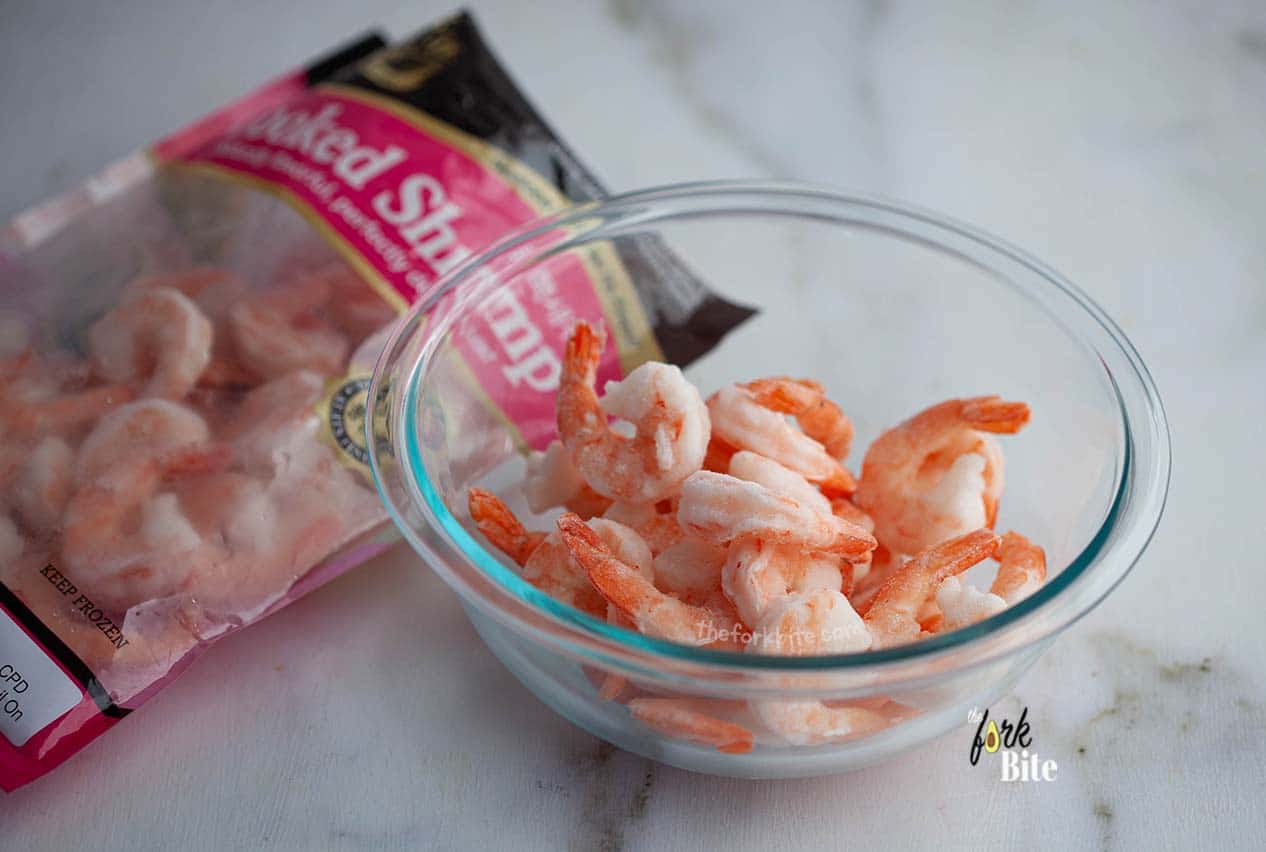
The basics
You might be familiar with blanching - a process that is often associated with vegetables before freezing them. It stops any damage to the enzymes, helps retain the veggie's color and texture, and keeps the taste beautifully fresh, ready for freezing.
After whatever you are blanching is par-boiled, the key is to submerge it in ice-cold water without delay. It stops the cooking process straight away.
Blanching frozen shrimp
Just like when you blanch vegetables when blanching frozen shrimp, you need to:
- Start with a large pan full of boiling water.
- Add the frozen shrimp carefully to avoid splashing, return to the boil and cook for between two and ten minutes according to the shrimp's size.
- When the shrimp begin to turn pink, take them out of the boiling water straight away and immerse them into ice-water.
- All that remains now is to drain and dry them before adding them to the recipe your cooking.
- If you want to serve them cold, you will need to refrigerate the shrimp until they reach the desired temperature.
Blanched shrimp uses
Typically, you blanch shrimp to use them in fresh dishes such as ceviche, where they are not heated but are rather "cooked" as they marinate in lemon or lime juice.
Other dishes that use blanched shrimp include Negara style sushi, shrimp cocktail, and sushi rolls. The only difference with these dishes is that the shrimp need to be blanched for longer until they are completely cooked, not just part cooked.
Just remember not to overcook as they will become tough and chewy. If you're adding them to other cooked ingredients, cook those ingredients first and add the blanched shrimp towards the cooking process's end.
Blanching shrimp tips
If you don't happen to live in a coastal area where you can get your hands on fresh shrimp, you're better off buying them frozen.
The reason is that in many instances, fresh shrimp has previously been frozen then thawed and will therefore only last in your fridge for a couple of days at the most.
If you can buy fresh shrimp, you're in luck, because with the care, you'll be able to judge the cooking to perfection (as they turn pink) to get that wonderful, firm, succulent texture.
Thawing shrimp before blanching:
- Place the shrimp into a colander, put it under the cold water faucet, and allow water to run over them for 10 to 15 minutes.
- To impart a little more flavor into the shrimp, add a little salt or perhaps sugar to the water you intend to use for blanching.
- Once you've finished blanching the shrimp, it's important to immerse them in the ice water to prevent any further cooking, or they will become tough and chewy.
How to cook frozen shrimp
Using frozen shrimp for an impromptu meal during the week.
There are several ways to go about cooking frozen shrimp.
- Once defrosted, you can grill them on your barbecue, so take them in a frying pan, or throw them into a shrimp gumbo.
- You can cook shrimp in its frozen state, but it can be a little more hit and miss between making sure they are adequately thawed and overcooking them.
Quick thawing
As I have already stated, shrimp when you run cold tap water over frozen shrimp, defrost within about 10 to 15 minutes.
The problem, however, is that going down this route tends to get them somewhat waterlogged.
Try this instead.
- Before putting the frozen shrimp into the colander, put them into a ziplock type bag and seal it.
- Then place the colander under the cold water faucet and run the water, and now and again, jiggle the bag around to move the shrimp to make sure they thaw evenly.
Cooking while frozen
When cooking shrimp from frozen, it's best to do so over a slow heat. It helps to ensure you don't end up with undercooked inners but overcooked outers.
- Immerse the frozen shrimp into a pan of cold water and heat. Just before the water is about to boil - while it is quivering before it starts bubbling - take it off the heat.
- Cover the pan and allow the shrimp to sit there in hot water, poaching until they turn pink. It will take around five minutes.
A recipe for frozen shrimp
It is okay to use frozen shrimp in recipes that involve cooking them in some sort of liquid like a sauce made with tomato as in jambalaya, or coconut milk if you are cooking a shrimp curry.
People often add frozen shrimp to a dish while the liquid is simmering.
- Before you add the shrimp, you should take the dish off the stovetop or out of the oven, then add them.
- The shrimp will then thaw slowly over about five minutes.
- Put the dish back on the stovetop or in the oven and reheat gently for a further five to ten minutes.
Can you refreeze the shrimp that has been previously thawed?
Like most seafood, shrimp is extremely versatile. They can be barbecued, boiled, fried, poached, sauteed, or marinated in a ceviche.
You can eat them hot or cold. They can be the star ingredient of your recipe, or you can use them as a garnish.
But when it comes to refreezing any seafood, you have to take great care. You can do it safely, but only if you observe the correct procedure.
Keeping Out of Danger
If you ever read the food safety pamphlets in supermarkets or follow food safety advice on the Internet, you will note that many emphases are put on the so-called "danger zone" for foodstuffs.
This zone covers a temperature range from 40°F to 140°F, wherein bacteria can proliferate.
Below this zone, bacteria's ability to reproduce is inhibited, while above the zone, it is all they can do to survive.
If you will be refreezing shrimp, it is critical to minimize the amount of time they are exposed to the food "danger zone."
When driving home from the supermarket with frozen shrimp, it is best to either put them on ice or in a cool bag, and when you arrive home, put them straight into the fridge.
When you thaw frozen shrimp, the way you do it is all-important.
Thawing is key
Size-wise, shrimp are ordinarily quite small and can therefore be defrosted quickly.
People thaw them in different ways.
- Some simply leave them out on the working surface at room temperature, whereas others tend to defrost them in cold water.
- Some people even defrost them in their microwaves.
But if you are going to be refreezing shrimp, you can use none of the above-mentioned methods.
Allowing shrimp to defrost on a working surface should never be considered, and if you go down the water or microwave defrosting routes, then it's important to eat the shrimp on the same day.
Defrosting in the fridge will, of course, take time. You should allow between 12 and 24 hours, which means planning ahead.
Why is that?
The reason it is safe is that your fridge always maintains a safe temperature, well below 40°F. That is indeed for what it was designed.
It means that your shrimp are kept at a safe temperature as they defrost.
Refreezing and safety
The safe storage zone for either fresh or thawed shrimp is quite short - just one or two days. The quicker you use them, the better.
If you have a change of plan and you will not be cooking them when you initially thought you would, put them into your freezer. The same thing goes for bringing frozen, partly thawed shrimp home from the store - straight into your freezer.
It's also an idea to write a note on the outside of the packaging to indicate that the contents have previously been thawed.
It will remind you, next time you take frozen shrimp out of your freezer to either used them or throw them away - not only for safety reasons but for quality reasons too.
Defrosting and refreezing shrimp too often detract from the product's quality.
That quality thing
As with any muscle tissue, shrimp contains a high proportion of water. Water freezes when it expands, and the walls of the shrimps' cells burst due to the pressure of the expanding ice crystals.
You will notice that once defrosted, moisture will have leaked from the shrimp, leaving the flesh drier and less tasty than it was when it was fresh or thawed only once.
In a worst-case scenario, the texture of the shrimp becomes mushy. It loses that distinctive firmness that is part of the attraction.
You can disguise this to a certain extent by using twice thawed shrimp in things like casseroles, dips, sauces, or soups.
How long can shrimp be refrigerated?
Shrimp perish quickly. To maintain their freshness, they require continuous refrigeration. To keep them at their best, both in terms of flavor and texture, you must correctly store these low-fat shellfish.
Suffice it to say that to follow food safety guidelines; you should use both raw and cooked shrimp as quickly as possible to avoid food poisoning.
For uncooked shrimp
So, now you know that you can store fresh shrimp for up to 2 days in your fridge and still maintain its quality.
I recommend covering raw shrimp with plastic film or putting it into a sealed airtight container.
Fridges weren't explicitly designed to maintain the quality of refrigerated shrimp. Therefore, it is best to put them into the coldest part of the refrigerator, where the temperature is between 32°F and 38°F. It will help to safeguard that all-important quality factor.
For me, the best way to store fresh shrimp is in a Ziploc bag, immersed in a bowl of ice inside your fridge. Used within two days, this will ensure top-quality shrimp.
Shrimp safety considerations
From a technical cookery point of view, cooked shrimp should reach an internal temperature of 120°F, by which time the flesh will become opaque and slightly pearly.
Don't forget that you should refrigerate the shrimp within two hours after cooking to prevent bacterial growth.
However, you need to be aware that if the room temperature is over 90°F, you must refrigerate the cooked shrimp within one hour and not two.
The other thing is that when you serve shrimp, you should ensure that hot dishes are kept hot while cold dishes are kept cold. (read: food safety)
For cooked shrimp
With the cooked shrimp, you can keep it safely in your refrigerator for up to 4 days. They are best kept in an airtight storage container. The shrimp can be heated in your microwave or steamed.
Reheated, pre-cooked shrimp should be evenly hot throughout to be safe to eat. I wouldn't recommend the freezing of cooked shrimp for use later on as it will detract from its flavor, texture, and quality.
Spoilage indicators
The spoilage indicators of shrimp are quite evident and easy to spot. They will become slimy in texture and will develop a horrible fishy smell. This relates to both cooked and uncooked shrimp.
When you buy fresh shrimp, to ensure you get the freshest, choose ones that look shiny and translucent and do not have a noticeable smell.
The fresher, the better, as this will increase the length of time for which you can keep it in your home fridge, without spoiling.
If any shrimp you are storing displays any of the signs of spoilage mentioned above, don't taste it, throw it away. When shrimp goes off, it causes food poisoning if consumed.
Do I peel shrimp before they are boiled?
A favorite way of cooking shrimp is boiling. Other popular methods include baking, grilling, frying, and sauteing. If you buy fresh shrimp with their shells on, you can peel them before boiling.
But whether or not you do so, decides on what you will be doing with the shrimp next.
When Buying
Whether you are shopping for fresh or frozen shrimp, it is best to buy ones that have their shells intact. Target "fatter" looking shrimp. Ignore anything that looks a little scrawny.
Following this tip will ensure you get the best tasting shrimp once boiled.
Preparation
If you are going to be boiling fresh shrimp, you should wash them thoroughly beforehand. With frozen shrimp, you should first defrost them either in cold water or in your fridge.
It is best not to thaw shrimp in your microwave or leave them in a warm place, as this will lead to a loss of flavor, moisture, and nutrients.
If you plan to cook the shrimp in a hot liquid, you need to take off the shells before cooking.
Technique
When boiling shrimp, you need to stir them in the water to separate each other. Regarding the amount of water to use, I recommend between four and six cups of water for every pound of unshelled shrimp. The cooking time is between five and eight minutes.
Peeling
Depending on how you and your guests feel about shelled or unshelled prawns, you can either peel them yourself, having first strained them after boiling or leave it to your guests to do so.
If you take the latter option, you will need to have some finger bowls on the table filled with warm lemon water.
Can you cook shrimp without thawing them?
If you've left it to the last second and you haven't come up with the right recipe, or you change your mind at the last minute, and your shrimp are still in the freezer, all is not lost.
You can cook them from the freezer without detracting from their flavor or texture.
Shrimp are usually individually quick frozen, which means that each of the little shellfish is contained within its ice shell.
This will allow you to remove the precise number of shrimp you wish to cook and immediately return the remainder to the freezer.
Precooking preparation
If you buy fresh shrimp from your local supermarket, they may be sold encased in their shells with their tails and sand veins still intact.
While they are still frozen, it is nigh impossible to de-shell and removes the vein.
If you will be presenting whole shrimp to your guests, it doesn't offer a problem as the guests do the shelling themselves.
But, if you will be presenting the shrimp in a sauce, it will be too messy for your guests to peel themselves, so you need to peel and devein before cooking.
Boiling or adding to a sauce
Boiling frozen shrimp is the easiest way of cooking them. The boiling water action not only dissipates the ice but also serves to thaw and cook the shrimp.
As they are quite small, it almost takes the same time to cook from frozen as it does from fresh.
Of course, when you add frozen shrimp to any sauce, the melted ice will water it down.
However, as the cooking continues, the excess water boils out, and the sauce becomes more concentrated, giving it a more intensified shrimp flavor.
Grilling, with accommodations
If you decide to grill frozen shrimp, you will need to adjust the way you season it. It's because, as the ice melts, any herbs or spices you added will runoff.
Once the shrimp has defrosted due to the grill's heat, you can then add some dried herbs and spices, or alternately, you can brush them with garlic butter or some other type of basting.
Sautéing with caution
If you intend to sauté your frozen shrimp, take care. As soon as the ice makes contact with the hot butter or oil in the pan, it will create splatter.
This splatter can cause minor blistering if it lands on you, or in a worst-case scenario, could even start a fire.
The way to avoid splatter, or minimize it, is not to have butter or oil too hot - just warm will do.
Once the ice has melted, turn the heat up if you wish.
Assessing food safety
As mentioned earlier, to ensure your shrimp are cooked properly, their internal temperature should reach 145°F.
At this stage, the flesh will turn opaque and pearly white, and the outer surface of the shrimp will be bright pink.
The other thing we talked about earlier is that when you handle the shrimp, they feel slimy, and they give off an unpleasant fishy smell, ditch them. They have spoiled.
When shrimp are still frozen, you cannot use touch and feel to ensure they are safe to eat.
- The only way you can test this is by cooking them, touching and smelling them carefully as they cook, or tasting a tiny sample once the cooking is complete.
- If you are in any doubt as to whether or not the shrimp have spoiled, the safest thing to do is to throw it into the bin.
How to cook frozen shrimps that still have shells
You can usually buy uncooked shrimp from your local store more cheaply than shrimp that has been shelled and cooked.
However, don't forget that fresh shrimp is a highly perishable product and will go off after only two or three days - even when kept in a refrigerator.
This is why it may be wiser to buy frozen shrimp. Shrimp that has been entirely frozen in its shell has a better flavor than peeled shrimp.
Here is your step-by-step cooking guide:
Step 1
Discard any packaging. Pour the frozen shrimp into a bowl and cover. Place into your refrigerator and allow to defrost overnight.
Step 2
Take a large saucepan and pour in 2 liters of water. Add 2 tablespoons of salt (preferably sea salt), put the pan on the stovetop, and bring the water to a boil.
Step 3
Carefully pour the shrimp into the boiling water. Lower the heat to medium, put the saucepan lid in place, and allow the shrimp to simmer for between three and six minutes.
Step 4
Check the shrimp's readiness by taking one out of the water and cutting it open with a knife. The color of the flesh inside should be white and opaque.
Step 5
Carefully pour the contents of the pan into a strainer or colander to let the water escape.
Step 6
Place the shrimp under the cold water faucet and thoroughly drench them to prevent further cooking.
Step 7
Once the shrimp are cool enough to handle, you can set about shelling them.
Step 8
- To completely shell the shrimp, twist off the heads, and pull off the legs.
- Remove the shrimp's body shell by lifting upwards and out from its body. As far as the tail is concerned, you can either pull it off or leave it on for presentation purposes. The choice is yours.
If the vein hasn't been removed from the shrimp, you can take it out using either a shrimp diveiner or a small paring knife.
- Run the blade along the back of the shrimp from head to tail, making a shallow incision. You can then access the vein easily with your fingertips.
Can I cook shrimp the night before?
Shrimp is a treat for all the family, and when you serve it, it should be at the peak of its flavor and have a nice firm texture. It tastes divine hot or cold and doesn't need very much processing or added flavorings.
The delicate, slightly sweet taste of shrimp makes it the perfect partner for virtually any fruit or vegetable. The journey from freezer to table takes far less time than any other type of protein.
It makes them the perfect choice when organizing a quick meal around your families' busy activities or work life.
Boiling
It only takes around three minutes to boil small or medium-sized shrimp as long as they are already defrosted. Larger shrimp will take a little longer - say five minutes in all.
If you're lucky enough to be cooking jumbo shrimp or prawns, the cooking time needs to be extended to 7 or eight minutes in total.
If you cook shrimp entirely the night before, you could find them a little rubbery.
You can get around this by blanching them for one minute in boiling water, providing you drain and refrigerate them straight away. When you come to finish cooking the shrimp the next day:
- Small to medium requires a two-minute boil
- Large requires a four-minute boil
- Jumbo should be boiled for seven minutes maximum
Broiling
If you are broiling on your grill, providing they are fully defrosted, shrimp need no longer than 4 to 5 minutes to cook through.
- Pat each shrimp, dry with a sheet of paper kitchen towel, then continue to baste them with butter or olive oil to keep them moist during the broiling process.
You can make great kebabs with your shrimp if you intersperse them between pieces of onion, tomato, and slices of green and red bell peppers. Broil them in one layer approximately half an inch apart.
They will take about two minutes on each side to cook through. The result will be beautifully tasty shrimp kebabs.
You can serve them immediately, or if you prefer, you can store them overnight in your fridge, and the next day, plunge them into boiling water for one minute before patting dry and serve.
Sauteed shrimp
You can saute your shrimp naked (the shrimp that is), or you can douse them in flour, cornmeal, Panko breadcrumbs, or even grated coconut for a thoroughly delicious crispy treat.
To keep their crunchy texture the next day, you can grill or broil your breaded shrimp.
To get your shrimp super crispy, Tyler Florence suggests putting breaded shrimp into a preheated pan and sautéing them in a mixture of butter and olive oil.
Remove them from the pan and dry between two sheets of paper kitchen towel. Then pop them straight into your fridge to stop them from cooking further.
When you come to eat them the next day, all you need to do is to boil for one or two minutes until the coating browns. Yum!
Shrimp salad
Because it doesn't need reheating, you can throw together a shrimp salad like ceviche at any time. Whether you boil, broil, sauté, or oven bakes the shrimps, they will be ready in minutes.
Small to medium require three minutes, large need five minutes, and jumbos up to 7 or eight minutes after shelling the shrimp. Toss them in amongst a salad of chopped lettuce, diced bell peppers, scallions, cooked pasta, and a little chopped onion.
Dressing wise you can serve them with coleslaw, sour cream, or ranch dressing. They all work well.
To finish off and sprinkle with a little black pepper, add a snippet of lemon peel, and sprinkle with lime juice for a zingy taste boost.
Other interesting recipes:
Full Recipe
Costco Cilantro Lime Shrimp (Copycat Recipe)
Pin RecipeIngredients:
- 1 lb shrimp (peeled with tails left on and deveined / I used the cooked shrimp for this recipe)
- 3 tablespoon unsalted butter
- 2 tablespoon garlic (minced)
- 1 lime juice (+ extra for serving)
- ½ cup Cilantro (chopped)
- salt and pepper to taste
- 1 teaspoon basil leaves (dried) (optional)
Watch the Video:
Instructions:
Prep the Shrimp:
- Using a paper kitchen towel, dab the shrimp dry, add ¼ teaspoon of salt, and a few fresh ground black pepper twists.
- Take your Microplane and peel off some lime zest, and are set to one side. Using a paring knife, cut the strips of zest in half lengthwise.
- Preheat your skillet on the stovetop and add a tablespoon of butter. Set two more tablespoons of butter aside for use later.
- With the butter bubbling gently over medium heat, add the chopped garlic and cilantro. Cook for less than a minute, gently stirring all the time.
- Add the shrimp, taking care not to stack them too much. Cook them for about one minute, stirring gently every few seconds to ensure that each shrimp cooks until all have turned pink. Note: You can try to cook in batches if needed to avoid over-crowding.
- The chopped scallions are optional, but if you wish to use them, now is the time to put them into the skillet together with the lime zest.
- Season with dried basil leaves (or your favorite seasonings). Give a quick stir to ensure that everything is coated in the sauce and cooked evenly.
- When done, slide the skillet gently off the stovetop.
Make the Butter Sauce:
- Keeping the skillet off the heat all the time, quickly add in the fresh chopped cilantro, the lime juice, and the two tablespoons of the butter you set aside earlier. Don't forget to add the lime zest.
- Your skillet will retain the heat long enough to melt the butter as you stir the contents of the pan to amalgamate everything, creating a delicious, silky, buttery sauce.
- Season to taste and serve with some wedges of lime and a sprinkling of fresh cilantro.
Notes:
- Place the shrimp into a Ziploc bag, seal it tightly, and put it into a bowl full of cold tap water. Let the shrimp thaw for about 20-30 minutes.
- Or you can put the ziplock bag into a bowl and bring it to the sink, turn on the cold water faucet, and run slowly into the bowl for approximately 15 minutes.
- From time to time, I have also made this dish using pre-cooked frozen shrimp. It works equally well but needs a little less time in the skillet as the shrimp is already cooked and only needs heating through for around one or two minutes.
extra tips:
- To make this recipe, substitute lime, and cilantro for lemon and parsley, and cook as directed above.
- To give your dish another shot of flavor, add a little dry white wine and lime juice towards the end of cooking.
- If, like me, you adore spiced up garlic shrimp, when you add the chopped garlic into the pan, throw in ½ to ¾ of a teaspoon of crushed chili flakes.
- If you want to forego the butter sauce’s full creaminess, you can use olive oil instead of butter. Use one tablespoon for cooking the shrimp, and towards the end, drizzle in another half a tablespoon of oil.
Nutrition Information:
Please note that all nutrition information are just estimates. Values will vary among brands, so we encourage you to calculate these on your own for most accurate results.

